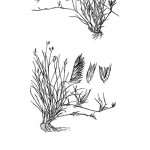Buffalograss
Buchloe dactyloides (Nutt.) J.T. Columbus
Poaceae
Description
Buffalograss forms sod with creeping stolons that take root at the leafy nodes. Nodes are smooth, and the 2 to 2.5 inches or 5 to 6.4 cm long internodes are flattened and shorter than in Common Curlymesquite. Foliage turns reddish brown after frost. The ligule is a short, ciliate membrane. Male and female plants grow in separate colonies. Female plants bear seeds in bur-like clusters among the leaves (top drawing). Male plants have flag-like seed heads with two or three spikes (bottom drawing). Blooms opportunistically and produces seeds throughout the year. Buffalograss is a perennial, warm-season, native species reaching 4 to 12 inches or 10 to 30 cm tall. Good grazing for livestock. Fair grazing for wildlife. Foliage that is cured on the ground can supply forage for mammals during winter. The seeds may be consumed by birds, and the leaves can serve as nesting material. Buffalograss serves as a larval host for the Green Skipper butterfly.Habitat
Grows on plains, prairies, meadows, pasturelands, savannahs, and mowed roadsides. Increases on heavily grazed tall-grass regions. Its native distribution includes parts of Canada, the United States, and parts of Mexico. It prefers well-drained loam, clay, caliche, or limestone. It does not prefer sandy soils.Images
Plant Characteristics
Seed Type: Caryopsis
Duration: Perennial
Stem Texture: Hairy
Growth Habit: Grasses, Sod grass
Leaf Shape
 : Simple with Pinnate or Parallel Venation
: Simple with Pinnate or Parallel Venation
Season: Warm
Distribution
 : 01 - Pineywoods, 02 - Gulf Prairies and Marshes, 03 - Post Oak Savannah, 04 - Blackland Prairies, 05 - Cross Timbers and Prairies, 06 - South Texas Plains, 07 - Edwards Plateau, 08 - Rolling Plains, 09 - High Plains, 10 - Trans-Pecos
: 01 - Pineywoods, 02 - Gulf Prairies and Marshes, 03 - Post Oak Savannah, 04 - Blackland Prairies, 05 - Cross Timbers and Prairies, 06 - South Texas Plains, 07 - Edwards Plateau, 08 - Rolling Plains, 09 - High Plains, 10 - Trans-Pecos
Distributions
Distribution refers to the ecological region in Texas that a plant has been found. You can also view a clickable map.
Book: Know Your Grasses (B-182)
Collection: Grasses


